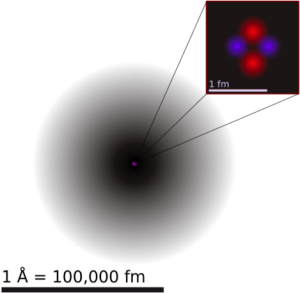19 2.1 Electrons, Protons, Neutrons, and Atoms — Physical Geology – 2nd Edition
For most of the 16 lightest elements (up to oxygen) the number of neutrons is equal to the number of protons. For most of the remaining elements there are more neutrons than protons because extra neutrons are needed to keep the nucleus together by overcoming the mutual repulsion of the increasing numbers of protons concentrated in a very small space. For example, silicon has 14 protons and 14 neutrons. Its atomic number is 14 and its atomic mass is 28. The most common isotope of uranium has 92 protons and 146 neutrons. Its atomic number is 92 and its atomic mass is 238 (92 + 146).
A helium atom is depicted on Figure 2.1.1. The dot in the middle is the nucleus, and the surrounding cloud represents where the two electrons might be at any time. The darker the shade, the more likely that an electron will be there. The helium atom is about 1 angstrom across. An angstrom (Å) is 10−10 metres (m). The helium nucleus is about 1 femtometre across. A femtometre (fm) is 10−15 m. In other words, a helium atom’s electron cloud is about 100,000 times bigger than its nucleus. Stanley Park in Vancouver is about 2 km across. If Stanley Park was a helium atom, the nucleus would be the size of a walnut.
Electrons orbiting around the nucleus of an atom are arranged in shells—also known as “energy levels.” The first shell can hold only two electrons, while the next shell holds up to eight electrons. Subsequent shells can hold more electrons, but the outermost shell of any atom holds no more than eight electrons. As we’ll see, the electrons in the outermost shell play an important role in bonding between atoms. The electron shell configurations for 29 of the first 36 elements are listed in Table 2.2.
| [Skip Table] | ||||||
| Element | Symbol | Atomic No. | Number of Electrons in the 1st Shell | Number of Electrons in the 2nd Shell | Number of Electrons in the 3rd Shell | Number of Electrons in the 4th Shell |
|---|---|---|---|---|---|---|
| Hydrogen | H | 1 | 1 | 0 | 0 | 0 |
| Helium * | He | 2 | 2 | 0 | 0 | 0 |
| Lithium | Li | 3 | 2 | 1 | 0 | 0 |
| Beryllium | Be | 4 | 2 | 2 | 0 | 0 |
| Boron | B | 5 | 2 | 3 | 0 | 0 |
| Carbon | C | 6 | 2 | 4 | 0 | 0 |
| Nitrogen | N | 7 | 2 | 5 | 0 | 0 |
| Oxygen | O | 8 | 2 | 6 | 0 | 0 |
| Fluorine | F | 9 | 2 | 7 | 0 | 0 |
| Neon * | Ne | 10 | 2 | 8 | 0 | 0 |
| Sodium | Na | 11 | 2 | 8 | 1 | 0 |
| Magnesium | Mg | 12 | 2 | 8 | 2 | 0 |
| Aluminum | Al | 13 | 2 | 8 | 3 | 0 |
| Silicon | Si | 14 | 2 | 8 | 4 | 0 |
| Phosphorus | P | 15 | 2 | 8 | 5 | 0 |
| Sulphur | S | 16 | 2 | 8 | 6 | 0 |
| Chlorine | Cl | 17 | 2 | 8 | 7 | 0 |
| Argon * | Ar | 18 | 2 | 8 | 8 | 0 |
| Potassium | K | 19 | 2 | 8 | 8 | 1 |
| Calcium | Ca | 20 | 2 | 8 | 8 | 2 |
| Scandium | Sc | 21 | 2 | 8 | 9 | 2 |
| Titanium | Ti | 22 | 2 | 8 | 10 | 2 |
| Vanadium | V | 23 | 2 | 8 | 11 | 2 |
| Chromium | Cr | 24 | 2 | 8 | 13 | 1 |
| Manganese | Mn | 25 | 2 | 8 | 13 | 2 |
| Iron | Fe | 26 | 2 | 8 | 14 | 2 |
| . | . | . | . | . | . | . |
| Selenium | Se | 34 | 2 | 8 | 18 | 6 |
| Bromine | Br | 35 | 2 | 8 | 18 | 7 |
| Krypton * | Kr | 36 | 2 | 8 | 18 | 8 |
Media Attributions
- Figure 2.1.1: Helium Atom QM. © Yzmo. CC BY-SA.
<!– pb_fixme –>
<!– pb_fixme –>


